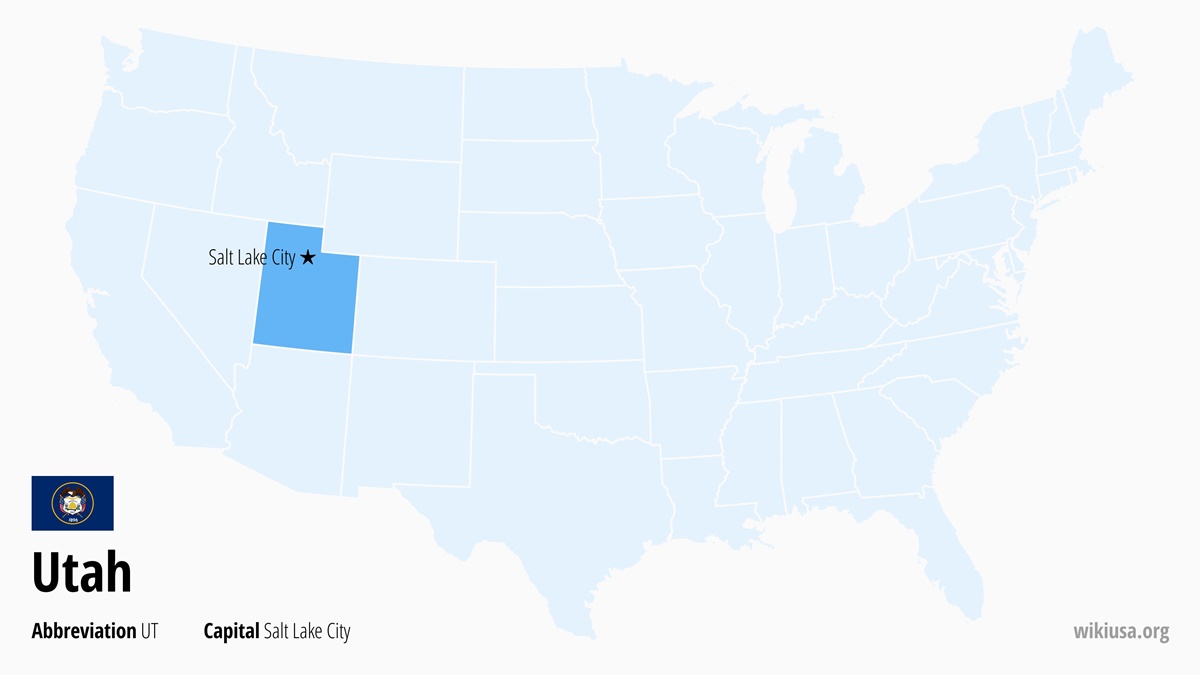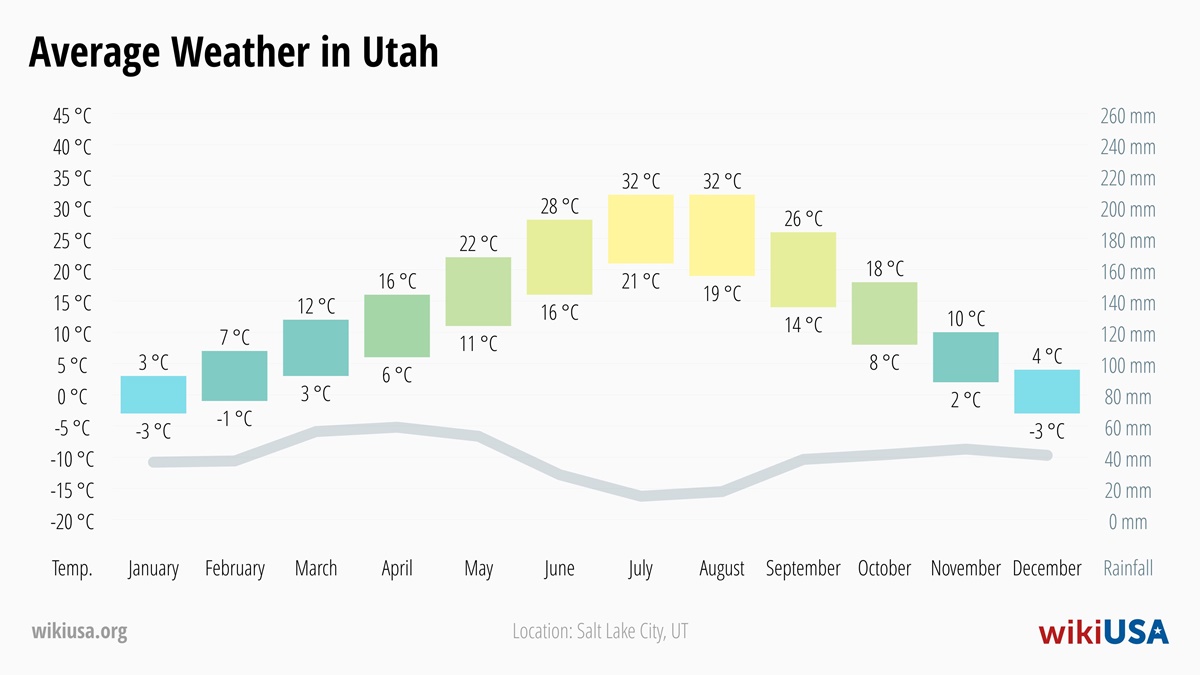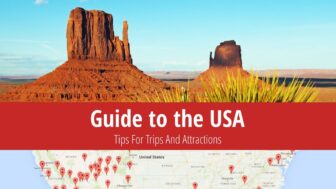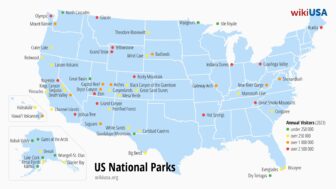Utah (UT) is located in the western part of the USA, and is known for its beautiful nature and many national parks. Utah is home to Zion, Arches, Bryce Canyon, Capitol Reef, Canyonlands and the Monument Valley Indian Reservation. Mineral extraction, technology, oil production, and agriculture contribute significantly to the state’s economy. Interestingly, approximately 50% of the state’s residents are members of the Church of Jesus Christ of Latter-day Saints (Mormons).
-
Table of Contents
Quick Facts
Name Utah Abbreviation UT Capital Salt Lake City Largest city Salt Lake City (Population: 209 593) Current time 5:44 Time zone MST (UTC-7), the state observes daylight saving time MDT (UTC-6) Population 3,271,614 (#30 most populous US state) Area 84,898 sqmi (#13 largest US state) Admitted to the Union January 4, 1896 (#45 state to join) ⭐ Capital of Utah
The capital of Utah is Salt Lake City, which was founded on July 24, 1847, at the shores of the Great Salt Lake, from which it takes its name. It became the capital of Utah Territory in 1856 and remained so after the state entered the Union in 1896.
🏙️ Largest City in Utah
The largest city in Utah is Salt Lake City, with a population of 209,593 in 2023. The second largest city is West Valley City with a population of 134,470 and the third largest city is West Jordan with a population of 114,908.
🕒 Time in Utah
The current time in Utah is 5:44. Mountain Standard Time (MST, UTC-7) is in effect throughout the state, with a switch to Daylight Saving Time (MDT, UTC-6) between March and November.
🧑🤝🧑 Population of Utah
As of 2023, Utah had a permanent population of 3,271,614, ranking it as the 30th most populous state in the USA.
📍 Area of Utah
Utah’s total area is 84,898 sqmi, of which 82,147 sqmi is land and 2,755 sqmi is water. Utah is the 13th largest US state.
-
Fun Facts About Utah
🧩 Utah Neighboring States
Utah is bordered by five American states. Nevada to the west, Idaho to the north, Wyoming to the northeast, Colorado to the east, and Arizona to the south.
📅 Date of Utah Statehood
Utah was admitted to the Union on January 4, 1896 as the 45th state in the order, its predecessor being the Utah Territory.
📛 Nickname of the State of Utah
The official nickname of Utah is “The Beehive State”. The name does not refer to beehives per se, but rather to the hardworking population and close-knit communities that are typical of Utah. The beehive was chosen as a symbol by the Mormons who began settling Utah in the mid-19th century.
The Mormon nickname “The Mormon State” refers to the fact that Utah is home to the Church of Jesus Christ of Latter-day Saints. Members of the church do not correctly refer to themselves as Mormons, as it is estimated that less than half of Utah’s population adheres to that religion.
⛰️ Highest Mountain in Utah
Utah’s highest mountain is 13,534 ft Kings Peak, which is part of the Uinta Mountains and is located in the northeastern part of the state near the Wyoming border. The mountain gets its name from explorer Clarence King, who was the first director of the United States Geological Survey, a government agency.
🏞️ Rivers in Utah
The longest river in Utah is the Colorado River with a total flow length of 1,448 mi. It is followed by the Green River (727 mi), the San Juan River (383 mi), the Sevier River (383 mi), and the Bear River (348 mi).
🎓 Universities in Utah
The largest university in the state is Utah Valley University with approximately 45 thousand students. Opened in 1941 in Orem under the name Central Utah Vocational School, it became a university in 2008 after changing its name several times.
The second largest is the University of Utah of Salt Lake City, which was founded in 1850 and today has about 35 thousand students.
In third place is Weber State University from Ogden, which is attended by over 30 thousand students. Its tradition dates back to 1889.
✉️ Utah ZIP Codes
The state of Utah has a dedicated range of zip codes 840xx-847xx, you can search by address on the USPS website. For more information on how the system works, see the article ZIP Codes in the USA.
-
Weather in Utah
The best time to visit Utah is in late summer and early fall, when temperatures are pleasant for exploring the beauty of the national parks. Winter, on the other hand, is ideal for visitors who want to enjoy skiing or snowboarding.
Spring in Utah is especially cool in the mountain areas, with temperatures in March still hovering around 41 °F to 50 °F. A rapidly changing environment is typical, with snow cover persisting in higher altitude areas. More favorable conditions for travel are in May, when temperatures range from 55 °F to 68 °F.
Summers in Utah are typically dry and hot, with temperatures occasionally exceeding 86 °F in the lower elevations around Salt Lake City. At higher elevations, such as around the Wasatch Range, temperatures continue to hover around 68 °F. There is minimal rain between June and August, which creates good conditions for outdoor activities.
Autumn in Utah is short, though winter sets in quite quickly in November. Temperatures in September and October are around 55 °F to 66 °F. The number of rainy days is low in autumn.
Winter in Utah is cold. In the Salt Lake City area, temperatures are around 27 °F to 37 °F, with mountain areas well below freezing. Snowfall in these locations is frequent and heavy, creating excellent conditions for winter sports.
🌡️ Average Temperatures and Precipitation in Utah
-
Things to Do in Utah
1️⃣ Zion National Park
Located in the southern part of the state near the Arizona border, Zion National Park is known for its steep red cliffs and deep canyons. Visitors can choose from many trails of varying difficulty in the park, the most famous of which is the 5.4 mi long Angel’s Landing trail with an elevation gain of 1,488 ft that leads to the top of the eponymous cliff with spectacular views. Free buses are available to travel throughout the park.
2️⃣ Monument Valley
Monument Valley is a system of red sandstone formations and rock towers set in a flat valley that is one of the symbols of the entire western United States. The area near the Arizona border is one of the traditional homes of the Navajo tribe, so visitors can take guided tours of interesting sites with descendants of the original inhabitants. A quicker tour can be experienced from the comfort of a car along the 17.0 mi long circular road.
3️⃣ Bryce Canyon National Park
Bryce Canyon National Park is located in the south of the state and is known for its distinctive sharp rock formations called hoodoos. The most beautiful views in the park can be experienced at sunrise or sunset. The park has 15 different hiking trails of varying difficulty, the shortest of which can be walked in 20 minutes, the longest of which can take up to 7 hours to complete.
An unusual experience is a winter visit to the park, when the red hoodoos are covered with snow and the trails can be used for skiing or snowshoeing.
4️⃣ Bonneville Salt Flats
The Bonneville Salt Flats in northwestern Utah resemble a giant mirror reflecting the blue sky. The flats, 12.0 mi long and 5.0 mi wide, are a remnant of the lake of the same name, and today the area is especially popular as a place for breaking vehicle speed records. In 2018, for example, Danny Thompson and his rocket-powered Challenger II reached a speed of 448.757 mph.
The salt flats are open to the public, who can be carried away by optical illusions, but the natural environment must be respected.
5️⃣ Arches National Park
Arches National Park is located in the eastern part of the state and is known for its deep orange natural sandstone arches, of which more than 2,000 can be counted. The most famous arch is the 52.0 ft tall Delicate Arch, which is considered Utah’s most iconic symbol.
The park has a number of marked hiking trails of varying difficulty that can be used to reach arches, rock towers, and overlooks. Arches is accessible year-round, with the best times of the year being in the spring and fall when the weather is pleasant.
6️⃣ Park City Ski Resort
Park City, east of Salt Lake City, is one of the best places for winter sports in Utah. It is home to several ski resorts with dozens of lifts and hundreds of different trails from beginners to professional skiers. In 2002, some of the Winter Olympics events were held here.
The range of sporting activities is also wide in summer, when conditions are excellent for mountain biking and hiking. The popular Sundance Film Festival is held in Park City every January.
7️⃣ Capitol Reef National Park
Capitol Reef is one of the less visited national parks in the USA. The park’s main attractions include sandstone cliffs and cliffs set in a desert setting, unusually complemented by historic orchards of fruit trees.
Visitors can pick pears, apples, peaches or apricots directly from the tree at the Fruita Orchard. There are a number of hiking trails through the park and good camping opportunities, making for ideal stargazing conditions.
8️⃣ Great Salt Lake
Great Salt Lake is the largest salt lake in the Western Hemisphere, located a few miles northwest of Salt Lake City. The lake’s salinity is approximately three times that of the ocean, making it very easy for visitors to float on the surface.
Several hiking trails provide access to the lake, from which herds of bison can be spotted. The area around the lake is popular with ornithologists as it is an important spot for observing migrating birds.
9️⃣ Canyonlands National Park
Canyonlands National Park is entirely covered by vast orange-brown canyons carved into it by the Colorado and Green rivers. The entire park is divided into The Needles, The Maze, and Island in the Sky, each offering unique views and different hiking opportunities. Of note is the Mesa Arch, which is a popular spot for watching the sunrise.
🔟 Grand Staircase-Escalante National Monument
Grand Staircase-Escalante is a National Historic Landmark in southern Utah known for its canyons, sandstone cliffs, and unique rock formations. Visitors can choose from several hiking trails that lead to scenic waterfalls such as Calf Creek Falls with its natural pool.
Once upon a time, 25 different species of dinosaurs lived in the Grand Staircase-Escalante area, and you can see their fossils at the visitor center.
-
Largest Cities in Utah
The table below shows the ten largest cities in the state of Utah in 2023, the source of the data is the United States Census Bureau, a federal agency whose main job is to count the population.
City County Population 1 Salt Lake City Salt Lake 209,593 Map of Salt Lake City 2 West Valley City Salt Lake 134,470 Map of West Valley City 3 West Jordan Salt Lake 114,908 Map of West Jordan 4 Provo Utah 113,343 Map of Provo 5 St. George Washington 104,578 Map of St. George 6 Orem Utah 95,519 Map of Orem 7 Sandy Salt Lake 91,943 Map of Sandy 8 Lehi Utah 90,227 Map of Lehi 9 Ogden Weber 87,267 Map of Ogden 10 South Jordan Salt Lake 84,528 Map of South Jordan -
Sports Teams in Utah
🏒 Ice Hockey (NHL)
The NHL includes a single team from Utah — Utah Mammoth, which is part of the Central Division in the Western Conference. The team joined the NHL in the 2024–2025 season under the temporary name Utah Hockey Club. The Utah Mammoth play their home games at the Delta Center in Salt Lake City and wear black, white, and blue jerseys.
🏈 American Football (NFL)
There is no team from Utah in the NFL.
🏀 Basketball (NBA)
Since the 1974 season, the state’s only NBA representative has been the Utah Jazz of the Northwest Division in the Western Conference. All home games are played at the Delta Center in Salt Lake City, and the club colors are yellow, black, gray, and white.
⚾ Baseball (MLB)
No team from Utah plays in the MLB league.
⚽ Soccer (MLS)
Utah is represented in the MLS by Real Salt Lake, and played its first season in the Western Conference in 2005. The team’s home stadium is America First Field in Sandy, and the club colors were burgundy red, cobalt blue, and gold.
-
Utah State Symbols
Utah has several enacted official symbols and several unofficial symbols, only a few of which are listed in this article.
State Flag of Utah
Utah did not begin using the existing flag with the beehive motif until March 9, 2024. The base of the flag consists of three horizontal stripes – the top blue, the middle white, and the bottom red. The white stripe evokes mountains in its shape, with a hexagon with a beehive inside.
The previous flag was used between 1913 and 2024 and consisted of the national emblem on a dark blue background. After its replacement in 2024, it acquired the status of a historical flag.
Great Seal of Utah
The Great Seal of the State of Utah has been used since April 3, 1896 to authenticate documents issued by the government. The main motif of the seal is a bald eagle symbolizing protection and sovereignty, which bears a coat of arms in its talons. The coat of arms features a beehive, which symbolizes industry and hard work. The two crossed American flags represent devotion and loyalty to the nation. The year 1896 commemorates the year Utah entered the Union.
State Song
Utah…This Is the Place, which was written for the state’s centennial in 1996, became the official song in 2003. The song was adopted at the urging of fourth-grade students at Syracuse Elementary School who found the original Utah anthem, We Love Thee, not amusing enough.
State Insect
In 1983, the honey bee (Apis mellifera), long before that one of Utah’s symbols, was chosen as the official state insect. The bee symbolizes hard work, productivity, and community building, which are considered characteristics typical of Utahns. The beehive is part of the flag and state seal.
State Reptile
The state reptile in 2019 is the venomous Gila monster (Heloderma suspectum). One of the few venomous lizards in the world, it is a native species in the USA and is found in southern Utah, Arizona, and New Mexico. The poison ivy is not aggressive, and attacks on humans are very rare.
State Animal
One of the symbols of Utah since 1971 is the Rocky Mountain elk (Cervus canadensis nelsoni), a large mammal that can be seen in the mountainous areas of the state. The wapiti are meant to symbolize Utah’s strength, pride and wealth, and their antlers are among the most valuable trophies.
State Tree
Since 2014, the quaking aspens (Populus tremuloides) has been the symbol of Utah; elementary school students who wanted to raise awareness of the tree pushed for the law. The Aspen Poplar was chosen for its ability to share the same root system within a colony, which is meant to figuratively represent the unity and cooperation of the people of Utah.
State Gem
The topaz became the state gem in 1969 to emphasize its importance to the state’s economy. Known for its golden to amber color, Utah topaz is found in several deposits across the state. The most famous are in the Thomas Range in western Utah.
State Fruit
The cherry was declared the official state symbol in 1997 and is one of Utah’s main fruit crops.
State Rock
The list of symbols was expanded in 1991 to include coal, which has historically played an important role in the state’s economy. Utah has some of the largest coal reserves in the entire United States, with mines in Carbon and Emery counties having been brought into operation as early as about 1881.

 10 Best Photo Places in the USA
10 Best Photo Places in the USA







Contribute with Your Question or Personal Experience